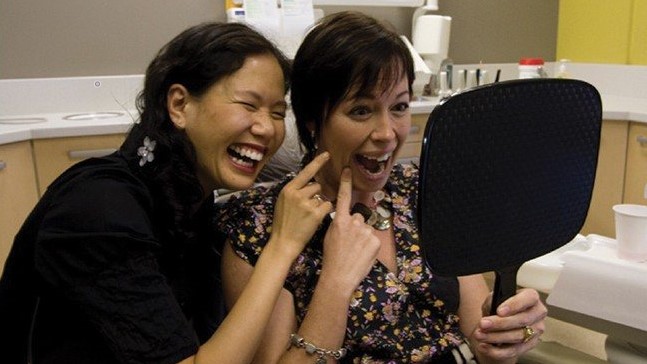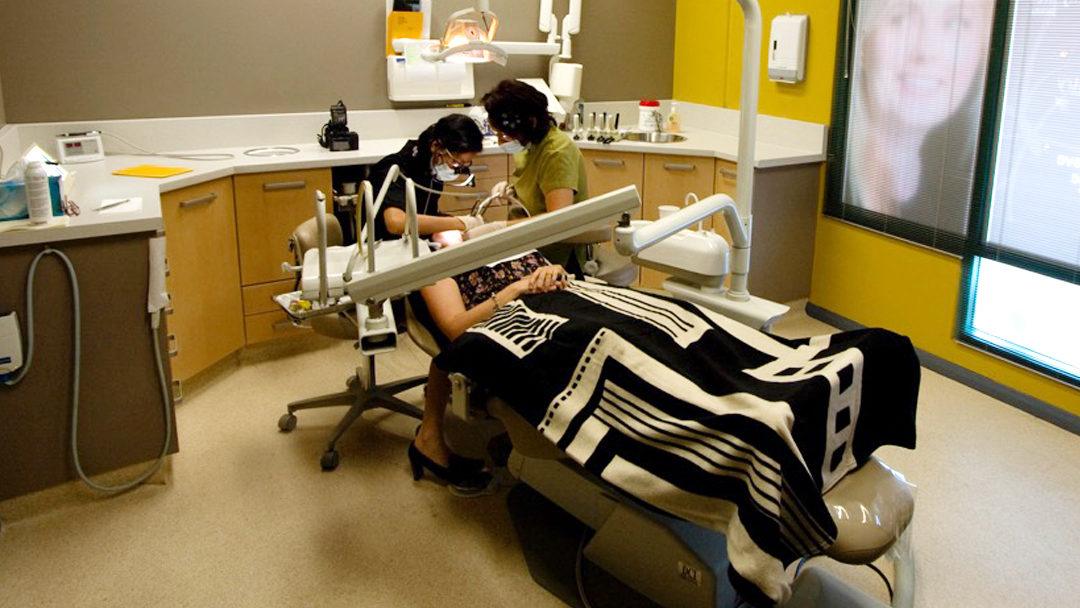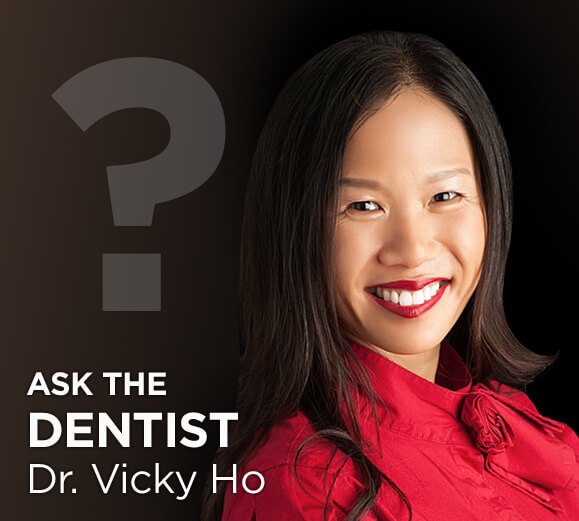
by Vicky Ho | 13 May, 2019
When teeth are crooked or overlapping, you may think that the only remedy is with some form of orthodontic treatment. In some cases, this may be true. In other cases, porcelain veneers may be used to correct the appearance of crooked teeth. Here are some things that your Perth dentists will consider: Tooth Shape Cosmetic dental treatment with veneers can do quite a bit for your smile. When working with veneers, we take into account the overall shape and size of your teeth. We want each tooth to have a nice overall size, width, and shape at the end of the cosmetic process, so in order to fix an overlap or misalignment, it may be necessary to cover multiple teeth. A Bright White Smile Porcelain veneers can be made in almost any shade of white – to match your natural teeth colour, or even go much lighter. This means that you can correct some minor alignment issues and brighten up your smile! If you are looking into whitening and aligning your smile, we advise getting teeth whitening first so that the veneers on the treated teeth will match your new shade so that your natural tooth enamel and veneers all shine as bright as your personality. Porcelain has a benefit that it does not dull over time, so they will act as the new baseline shade for future maintenance. Facial Symmetry When you address cosmetic flaws in a smile, it does a lot for the whole face. When more teeth show as you smile, teeth no longer appear crowded. When teeth are properly spaced, sized, and shaped, the proportion... 
by Vicky Ho | 23 Mar, 2019
Many of your Perth neighbours elect to have some form of cosmetic dental work to correct a crooked smile. With today’s advanced technology, there are multiple options available. At the Smile Design Studio, we offer the popular orthodontic procedure, Invisalign. Invisalign is a proven cosmetic dental procedure that corrects the orientation of your teeth through multiple sets of almost invisible plastic aligners. Each aligner is slightly tighter than the last and gradually moves your teeth into the desired alignment. Whenever you come in to see us for your scheduled check-up, we’ll check the progress of your teeth. We know how much they should be moving and what the final result will look like. Your aligners are nearly invisible to all but the closest observers, so your teeth will get nice and straight without becoming insecure about how you look as you might with traditional braces. These clear aligners are smooth so that they don’t rub against your cheeks and gums when you’re wearing them. Brush with Care When cleaning your aligners, just brush them like you would brush your own teeth. Just don’t be too rough on them. Don’t forget to clean your own teeth as well every morning and before going to bed. Don’t use toothpaste when you brush your aligners because it could end up scratching the plastic material. Use a soft toothbrush with plenty of water and liquid soap and gentle movements whenever you clean your aligners. Put Aligners on Clean Teeth Whenever you take your aligners out to eat or drink, please clean your teeth before putting them back in. Bits of food and bacteria... 
by Vicky Ho | 20 Mar, 2019
Veneers are a simple and effective treatment to enhance your smile – to close up gaps, brighten your smile or even to fix a chipped tooth. There are two types of veneers that we use in our practice – porcelain and composite resin. Composite veneers be fitted in one visit, while porcelain veneers will be made in a laboratory and may take a couple of weeks to be ready for fitting. Porcelain is made from an organic natural glass material, whereas composites are made from a type of plastic artificial material. Which One Looks Nicer? Over time, the composite may become stained since the material is slightly porous. The surface may also start to become a little dull as the surface is not as durable as porcelain. On the other hand, porcelain maintains its shine since it’s made from an extremely durable material, and the colour is consistent since it’s not made from a porous material. Composite resins will not shine up as much as porcelain, even when newly applied. If you tend to drink a lot of soft drinks or dark coloured food such as curries or berries, you may find that porcelain is the better choice. Choosing the Perfect Colour for Your Smile Composite material comes in limited shades of white, so your final colour may not be the desired shade, whereas with porcelain, there are an almost unlimited range of shades and characteristics. Porcelain can look just like your natural teeth using advanced ceramic layering techniques. The lab uses a highly controlled fabrication process to allow for precise measurements and consistency of colour. Composite material... 
by Vicky Ho | 2 Mar, 2019
If you suffer from persistent headaches, neck aches, you could be at risk for TMJ Syndrome. Symptoms of people who suffer from TMJ syndrome can often present with the following symptoms: 1. Persistent headaches, often in temporal areas, but also commonly at the base of the skull. Sufferers of TMJ often wake up with the headaches, and these can often be worse on one side. 2. Persistent neck pain or stiffness, unable to turn head freely. These symptoms can range from mild to severe and often are constant to a daily occurrence. 3. Grinding or clenching or Bruxism. There are often signs of wear on teeth indicating bruxism or clenching. The patient may or may not be aware of this as it often happens in the sleep. We can assess the degree of wear and that will usually be an indication of this occurrence. 4. Abfractions or notching at the necks of some teeth. The scientific term is Abfractions. These are caused by flexion of the teeth from grinding or clenching and it causes the tooth to flex and the enamel to chip off the side necks of teeth leaving notches in the tooth structure at the gum level. 5. Jaw or facial muscular pain. The facial muscles can be tense or sore, like a constant ache. It can sometimes feel like pain behind the eyes. 6. Ear congestion. This is common and can be on one side or both. The sensation of blocked ears, or difficulty in equalising pressure or constant pressure in the ears. 7. Ear Ringing or Tinnitus. 8. Head tilts, in every direction except upright.... 
by Vicky Ho | 19 Jul, 2017
Despite its relatively high cost, the use of all-on-four implants has gained favorable popularity in Australia. The procedure is used for improving the efficiency of prosthetic dentistry, and is considered one of the best permanent procedures for that purpose. The implants are placed on key strategic points of the maxilla and/or mandible as fixed pillars designed to support the addition of multiple other dental implants. If you have several missing or damaged teeth, this is the recommended procedure that most Australian dentists would suggest. About All-on-Four Implants All-on-4 implants involve all teeth being supported on four key implants. This is a complete rehabilitation procedure that is suggested for severe or partial edentulism, when patients are toothless to a certain extent. The four implants are placed in the anterior maxilla, and fixed in areas where the bone structure’s density is highest. This is done for the purpose of increasing the structural solidity of the patients’ teeth, and can support a set of fixed prosthesis featuring a number of 10 to 14 implants. Swedish medical researcher, Professor Per-Ingvar Brånemark, was among the first to pioneer this complex dental procedure as early as 1978. Since then the popularity of all on four implants has extended worldwide, and today there are many clinics in Australia specializing in the procedure and offering highly competitive prices. All-on-four implants are essentially part of an innovative treatment technique that use both structural implants designed to support a fixed bridge and angulated implants secured in the back to help avoid the problems caused by distorted anatomical bone structure and bony deficiencies. The latter, along with the introduction of...









